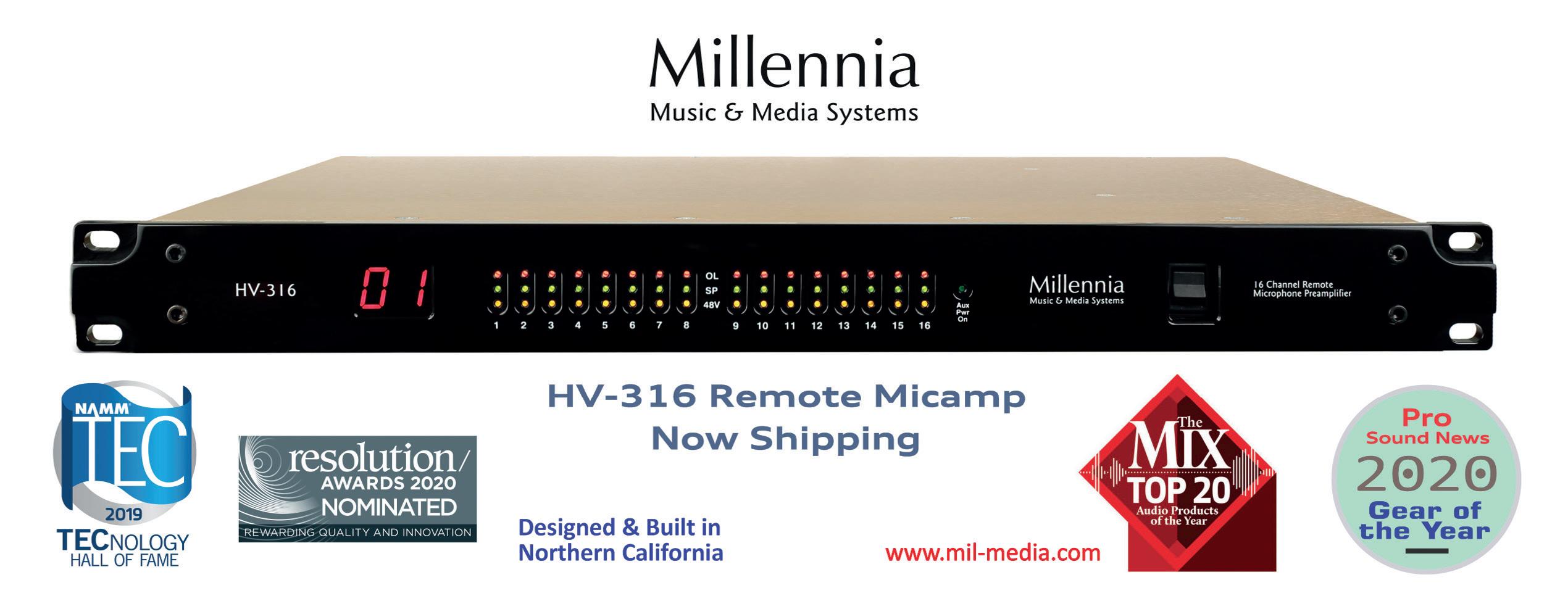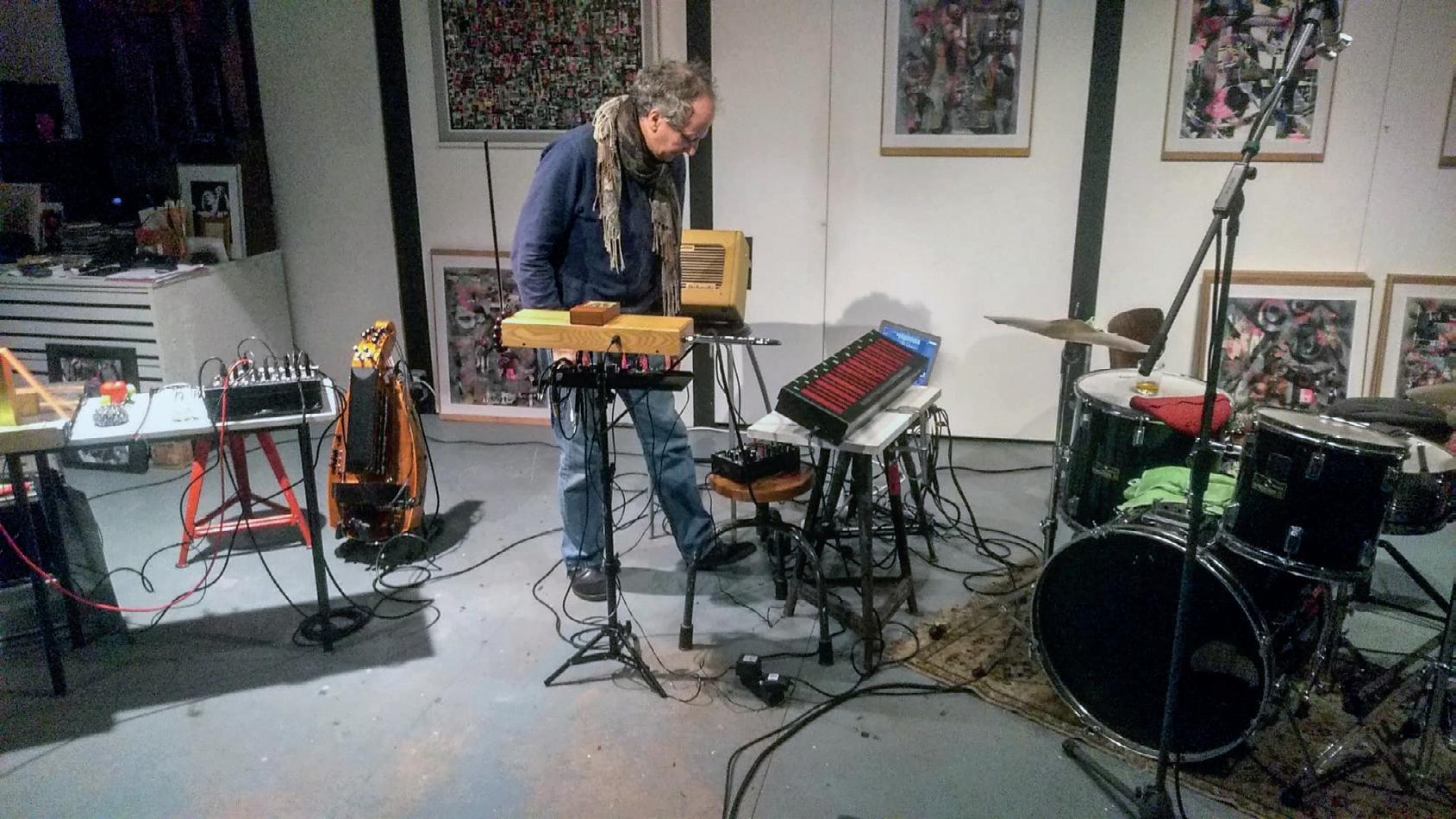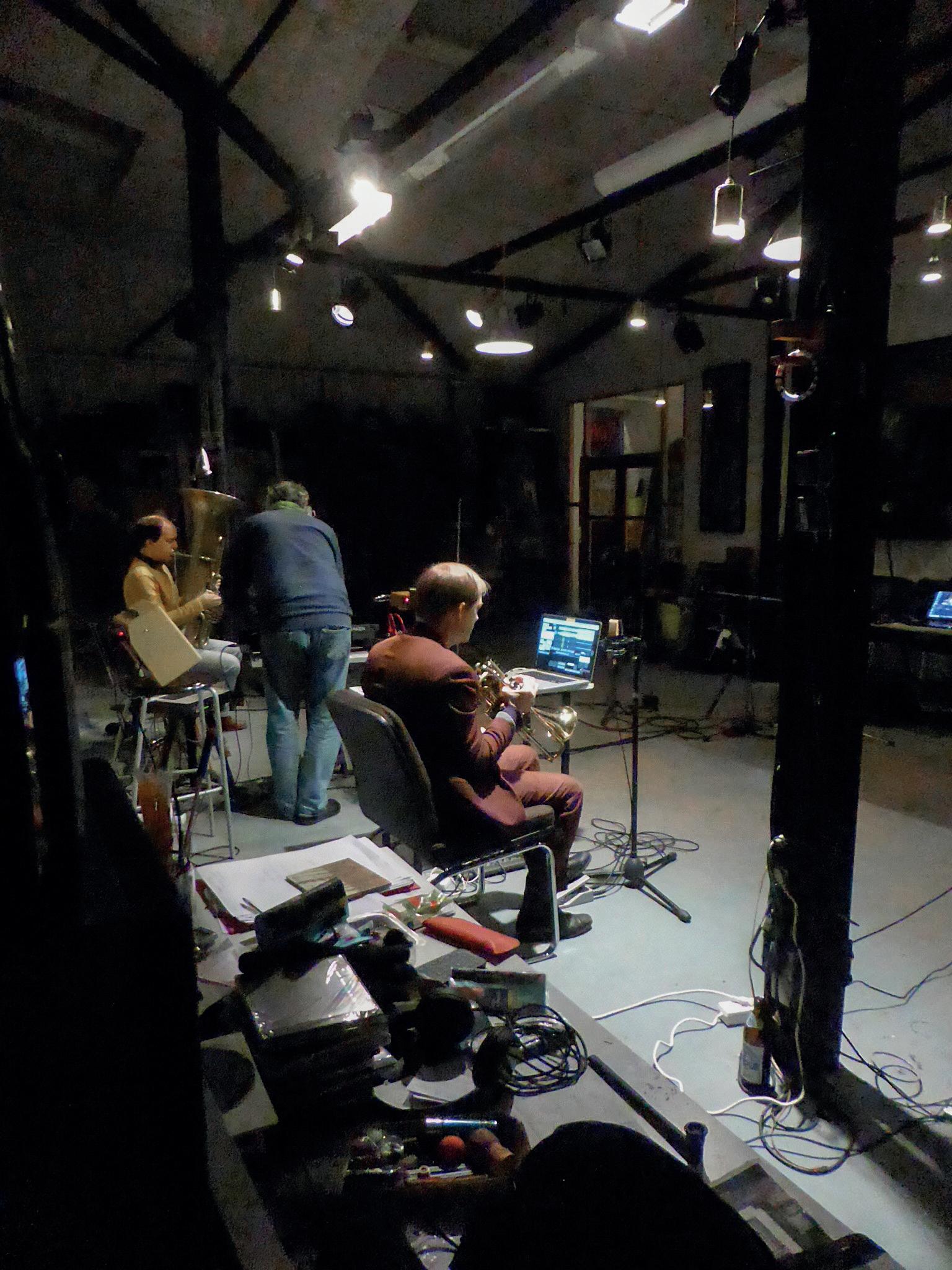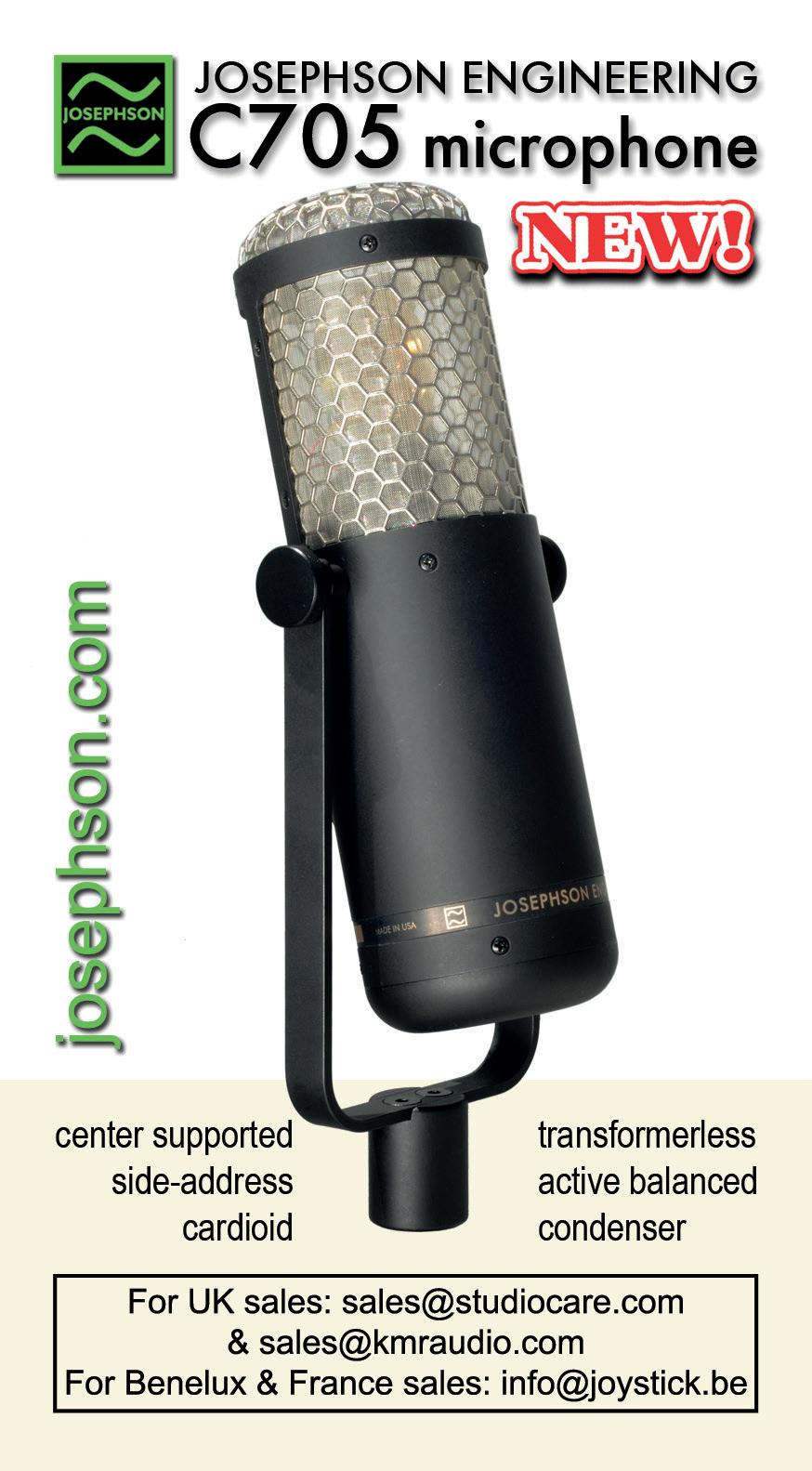
11 minute read
Jon Thorton explores an old technology that’s seen a new lease of life, and a market that’s offered up a whole range of new options in the last few years
Electro-acoustic livestreams
Musician and recording engineer ANDREW LEVINE lays out his practical solutions to the challenges of capturing experimental improvised electro-acoustic music for a skeletoncrewed lockdown show
When I started my recording career I was singularly concerned with classical music; chamber music, organ recitals, choral concerts and orchestral repertoire. However, 2007 saw my first serious recording of more contemporary music, specifically MASS, an audio-visual performance by Looper and John Tilbury. This was followed by a series of recordings at the “blurred edges”, the festival of the Verband für Aktuelle Musik Hamburg/ VAMH (Hamburg’s association for contemporary music). I heard and recorded a wide range of rather unusual repertoires there, with an extremely wide dynamic range and lots of unusual (dis-)harmonies.
This was not strange music to me, however, as I had been a part the Arbeitsgemeinschaft Neue Musik/AGNeM (Working group for contemporary music) — an ensemble founded by music teacher and bassoon player Klaus Risch way back in 1967 — as far back as the 12th and 13th grade. So the shift was more akin to finding my way back to something that I heard as ‘strange’ chamber music.
Jump to March 2010. I was in Paris for a few weeks recording the 10th anniversary of the Festival Oboe, and on the fringe of the programme of predominantly chamber music concerts I captured a performance of an electro-acoustic trio comprising Axel Dörner (trumpet and FX), Jean-Philip Gross (synthesiser) and Christine Sehnaoui (saxophone) at Les Instants Chavirés in Montreuil. This was definitely something else, both in terms of tone and technology. Suddenly, I needed to understand and implement the musicians’ aesthetics, balancing the direct line-level signals with the acoustic components of the performance.
Here, I also discovered one of the main issues in capturing pleasing recordings of these kinds of ensembles: that the amplification used to project the electronically produced and/or modified sources collides with the purely acoustic elements. There is often substantial sound pressure level on stage from the PA, and even when its influence can be minimised through the use of in-ear monitoring, most venues reflect a lot back into any open mic.
The Theremin
instrument, invented in 1919/20. On a whim, I ordered a Moog Etherwave Plus. My initial experiments with that soon turned into duos, trios, and other experimental collaborations. One performance, a 2016 concert with Manuel Gera — one of the two organists of St. Michaelis, Hamburg, involved a church organ featuring 44 registers. This made me painfully aware of the restricted timbral palette of my instrument, and the need to extend these textures in order to enrich performance and expand possibilities.
The Etherwave’s two knobs, for controlling waveform and brightness, are no match for even a small organ, so I started to experiment with a Gretsch G5222 Electromatic Amp. The tube circuitry of that (12AX7 and 6V6 for the 6’’ chassis) produces some harmonic distortion at higher levels, which helps a bit, but it was not enough. It was definitely time for a sonic upgrade.
The 0-Coast
After some research, I ended up purchasing a semi-modular (internally pre-patched) 0-Coast by Make Noise Music. This flexible, yet flat and portable unit is based on the additive synthesis paradigm of the US west coast (think Buchla), rather than the subtractive approach of the US east coast (exemplified by Moog). The 0-Coast sports two unsymmetrical dual-mono line outputs, one of which is fixed gain, while the complement features an attenuator. I now use the latter for my amp, the former to record the signal.
Thus, since 2017 my Theremin has featured an interface for the dedicated soundproducing component. The control voltages of both antennas — the round one usually dedicated to volume and the straight one to pitch — plus a gate output, provide experimentally inclined musicians with a host of options, as long as one is happy enough with monophonic voicings.

/ Trumpet player Axel Dörner with his customised instrument augmented with controllers for Max/MSP, and a vintage AKG414 to capture the acoustic elements of his performance
The Continuum
In 2019 encountered the Continuum Fingerboard, an instrument invented and developed in the 1980’s and 90’s by electronic engineer Lippold Haken of Haken Audio. It is possibly the most tactilely expressive electronic instrument in existence, combining a touch-sensitive area with a sheet of neoprene covering an array of spring-mounted metal rods sporting Hall Effect sensors on each end. A dedicated sensor readout mechanism features an astounding 0.33ms resolution and since the early 2000's the instrument has incorporated a polyphonic digital synthesiser, the Eagan matrix, named after its designer Edmund Eagan.
I didn’t want to pass up the chance to go polyphonic with such a device, and fortuitously acquired a half-size example from Daniel Grabois, professor and founder of the ElectroAcoustic Research Space (EARS) at the University of Wisconsin-Madison. It provides a stereo output, plus digital AES/EBU in- and outputs on XLR (these have changed to coaxial S/PDIF on the current version, alongside a headphone output plus a pair of unsymmetrical line outputs). The Continuum works at a native sample rate of 96kHz, optionally 48kHz and can be clocked externally off of its digital input.

/ Trumpet player Axel Dörner with his customised instrument augmented with controllers for Max/MSP, and a vintage AKG414 to capture the acoustic elements of his performance

This addition saw my live performance rig expand to Etherwave+0-Coast with the Continuum–and the occasional STEIM Cracklebox insert. I feel the combination is a wonderful match for creating a wide range of esoteric and interesting textures while providing a great performance tool. For concerts, I generally feed the stereo out of the Continuum to my monitor speaker and the PA while recording the digital output with my audio interface — a Metric Halo ULN-8 or 2882 3d with AES/EBU (+S/PDIF) EdgeBus port card. The digital output of the interface feeds the live mix to my Blackmagic ATEM TV Studio Pro’s AES/EBU input (from XLR to BNC — don’t ask me why) so I clock the domain from the Continuum’s feed, refreshed by my interface’s PLL.
February 2021 Livestreams

In Germany, live concerts with an audience have been prohibited since November 2020, but I now appreciate the advantages of streaming events. Experimental and freely improvised music has always existed in a niche, even in an active environment for this kind of experimental endeavour like Berlin. I have come to realise that you can draw significantly larger crowds online than would have attended in-person, provided you create an interesting proposition and invest sufficient time into promoting the stream on social media.
For shows on February 6th and 7th, I utilised the Kühlspot Social Club in Berlin-Weißensee, a gallery run by Christoph Kühl and filled with his father’s sculptures and his own paintings. It is one of the established concert locations of the Echtzeit-Musik scene in Berlin; a very nice sounding large rectangular space with a slanted ceiling and skylight. Wi-fi provision was solid, but I arranged for a direct line to the router in the atelier next door. After all 30m of CAT-5e Ethernet cable is an easy thing to transport.
The visual end was covered by five Canon DSLR’s. Four were inexpensive models with APS-C sensors to capture insert shots for later edits, but just one — a 5D MkIII — would provide a wide-angle shot for the stream. I chose this reductive approach to the livestream visuals because it was prohibitively taxing to also be in charge of the live visual mix and expensive to delegate the task. It is hard enough to switch between the mindset necessary to plan for, set up and manage the audio-visual recording and the empty mind and attentive ears required for intuitive music making.
In planning for the audio part of the session, my first plan was to use a Planar Ambisonic setup: a central AES R88 mk2 stereo ribbon in M/S configuration (for the X- and Y-channel) plus a top-mounted Earthworks QTC-1 as W-channel for the non-directional pressure component. I also wanted to stick two DPA 4060’s to the walls left and right as boundary layer pickups. In a refined design, however, I switched the Earthworks for a Core Sound TetraMic with tetrahedral capsule configuration. This allows for the extraction of a nearly optimal omnidirectional characteristic, while also supplying the information for optional height channels.
However, the first option demanded five channels, and the second eight! So, compromise became the key — and, considering the mounting complexity of the whole endeavour, I chose a simple AB as main microphone. Two of the three musicians on each evening were producing their sounds electronically, anyway, providing a good excuse to not go overboard in the acoustic realm.
Mic choices
The purely acoustic collaborators across the two performances were the Australian percussionist Samuel Hall on Saturday and the British tuba player Jack Adler-McKean on
Sunday. For them, I had pragmatically decided on a Rode NT4, a preconfigured and easy-toplace XY-mic, that has been a great companion for nearly 20 years. This, together with the runtime stereophonic pair — two (Neumann U-87 like) ‘Browny’ large diaphragm condensers, made by Attila Czirja’k of United Minorities — spaced at 70cm captured the ‘real’ manifestation in time and space well. I was all set.
One add-on to measuring runtimes: I not only captured the distance of the XY-spot to the (middle of the) main microphone but also the distance of the Theremin’s amp to the central AB. Better an extra measurement you choose not to use than the lack of an exact timing reference! Since there was no physical audience to consider I moved the PA speakers to face towards the ensemble, making sure it was primarily reflections of the wall behind us that reached the microphones.
Electro-acoustic options
My electro-acoustic collaborators on the first evening were the Swiss luthier Caroline Cecilia Tallone (aka K Lì) with a pickup-equipped hurdy gurdy and an assortment of amplified objects. Caroline fed the sum of her signals from an analogue mixer to one line input of my interface. The second evening the German trumpet player Axel Dörner sat in. His instrument was augmented with a contraption designed by Sukandar Kartadinata; a steampunk-like clampon offering physical controls — buttons, knobs and sliders — to enable realtime control of Max/MSP patches for FX, realtime sampling, and quadraphonic panning among other things. Axel supplied a stereo feed from the interface connected to his laptop, alongside a fine-looking 1980’s AKG C414 to capture his trumpet acoustically. After I had unpacked, set up and tested all instruments, recording and streaming gear I had sufficient time to relax — at least on the second evening. The soundcheck for the recording levels and live monitoring went smoothly, the only issue arising being the difficulty of accurately judging the headphone mix while in the same space with monitoring turned on. A separate room would have helped to optimise the balance, but then again I was part of the ensemble so had to remain in my position.
A measured success
Since the focus of this session was primarily the creation of spontaneous music and provision of a satisfactory livestream — but optimal tracking of audio with the aim of being able to create a convincing audio and visual mix later — everything worked well. A multi-cam livestream, with a fluidly adapting audio mix would have demanded at least two additional specialists, and made the venture more logistically and financially taxing. The presence of the virtual live audience gave the gigs a concert feel, which fed back into the performance and banished the spectre of arbitrariness that can easily creep in with isolated sessions. The moment has to count, then and there, and I think we succeeded in capturing that sense and acceptable audio options for the final mix.
You can hear an edited excerpt from the beginning of Saturday's performance, Box Full of Waves — featuring Caroline Cecilia Tallone / K Lì (hurdy gurdy & amplified objects), Samuel Hall (percussion) and Andrew Levine (Theremin+synth & Continuum) — at youtu.be/AV_-kjsV9zc.
Not getting the newsletter? Don’t panic!

Sign up at www.resolutionmag.com/newsletter for the all-new, fortnightly Resolution email newsletter, featuring exclusive Resolution features and content, news and competitions, and more!



FORWARD THINKING AUDIO GEAR TITAN
COMPRESSOR LIMITER

www.davehilldesigns.com
Dave Hill Designs SHW 0914.indd 1 14/08/2014 09:04








